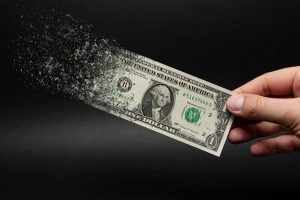A Reacquaintance with Inflation: Safe Havens in Short Supply
 An entire generation of workers, executives, and entrepreneurs has never experienced inflation and know the phenomenon only from history books. The Great Inflation of the 1970s is usually attributed to the sudden rise of oil prices after OPEC asserted its power in the wake of the Yom Kippur War. However, monetary policy loosened on the wrong side of the Keynesian equation also played a part.
An entire generation of workers, executives, and entrepreneurs has never experienced inflation and know the phenomenon only from history books. The Great Inflation of the 1970s is usually attributed to the sudden rise of oil prices after OPEC asserted its power in the wake of the Yom Kippur War. However, monetary policy loosened on the wrong side of the Keynesian equation also played a part.
Those were different times indeed when Richard Nixon, a staunch Republican, continued to spend lavishly on the Great Society and the Vietnam War both inherited from Lyndon Johnson, his Democrat predecessor. Arriving in Washington as a fiscal conservative, President Nixon soon and agreed to a big expansion of Social Security legislation and the imposition of wage and price controls. He also made the dollar into a fiat currency by severing its last link to gold, sparking a major devaluation, and slashing the value of the petrodollars held by Middle Eastern oil barons.
The Nixon experience holds warnings for today’s policymakers. By forcing the US Federal reserve to keep interest rates low – thus ensuring full employment and his own 1972 re-election – President Nixon set the stage for the long recession that was to follow, and which saw inflation rise to 14% in 1980 and jobless numbers to 10%. President Nixon, by then long gone, essentially got the worst of both worlds by stubbornly ignoring inflationary pressures.
Different, Dangerous
The present moment is slightly different, and much more dangerous, from the one lived in the 1970s. Today, central bankers enjoy precious little monetary wriggle room thanks to their bloated balance sheets and near-zero interest rates. Structural factors that kept inflation at bay, such as efficient global supply chains, are crumbling.
Though OPEC may constitute a spent force, energy prices are being pushed to record-highs by war and fears of climate change. Fiscal discipline has taken a hit as governments rich or poor bankrolled businesses and households to the tune of untold trillions during the corona pandemic.
All our collective peccadillos – from structural overspending and geopolitical intrigues to reckless globalisation and carbon emissions – seem to have merged into one Big Fail. In February, the world’s 30 most prosperous countries registered an average 7.7% jump in consumer prices, up from just 1.7% in the same month last year. Central banks have, of course, responded by (tentatively) raising interest rates but consumers and business alike may have trouble adjusting to the coming liquidity squeeze. Absent accommodative financial conditions, historically high levels of private and public debt could well become problematic.
Saddled with a $9 trillion balance sheet, the US Federal Reserve now seems determined to squash inflation by aggressively raising interest rates and offloading treasuries and mortgage-backed securities at a monthly clip of about $105 billion. During her Senate confirmation hearings, Fed vice-chair nominee Lael Brainard invoked former chairperson Paul Volcker whose tight monetary policy tamed inflation in the early 1980s – and sparked a deep recession.
Ms Brainard said that inflation would be particularly painful to households with limited resources and warned that price increases will likely outstrip wage growth, depriving workers of purchasing power to the ultimate detriment of the entire economy.
Not Amused
Ms Brainard is also troubled by the effect on already stretched global supply chains of both the war in Ukraine and the reimposition of draconian lockdowns in mainland China which is battling a resurgence of the Corona Pandemic. During the hearings in Washington, Ms Brainard suggested that both developments stress the need for a decisive tightening of monetary policy. Markets were not amused. Bond prices dropped (as yields rose) whilst the S&P 500 stock index interrupted a modest rally to retreat 1.3% after Ms Brainard was done speaking.
The risks associated with the Fed’s newfound assertiveness are considerably higher than in Mr Volcker’s days. Back then, the Fed chair risked a recession. Now, central bankers must also factor in a leveraged financial sector bloated with derivatives. The financialisaton of most industrialised economies – aka the mother of all bubbles – may yet exact a terrible toll as increases in productivity are unlikely to compensate for higher interest rates. Another notable difference with former times is that the US debt-to-GDP ratio currently stands at an all-time high of 137% (2021) versus a record low of barely 32% in 1981.
The Fed and other major central banks are, in essence, looking to (fairly) rapidly unwind quantitative easing in its many forms without causing the patient to succumb to withdrawal symptoms.
In case this gets a bit too hectic, watch the price of gold futures. Currently flat or falling marginally and decidedly unexciting as an asset class, the bulls have encountered some resistance to break through the $2,000 per troy ounce ceiling as the yield on treasury paper improved. However, as central banks get into a funk over inflation, geopolitical tensions persist or escalate, and the unwinding of QE introduces negative pressures on the stock market, safe havens such as gold will likely be in short supply.
You may have an interest in also reading…
Working from Home, or Living at Work? Hybrid is ‘Hell’, and a Return to Office may be Worse
The future of work is remote, and many of the world’s corporate heads — and workers — are ready to
Glued to the Box, or Linked to a Laptop? Streaming is Up-ending Entertainment
Digital consumer habits are reshaping the entertainment industry. A recent report by consulting firm Deloitte found that UK residents are
Avoid the Sucker-Punch of Online Scammers — Keep Your Guard Up!
Experts reveal how businesses and sellers can spot online payment fraud. When it comes to e-commerce, shoppers aren’t the only



















































































